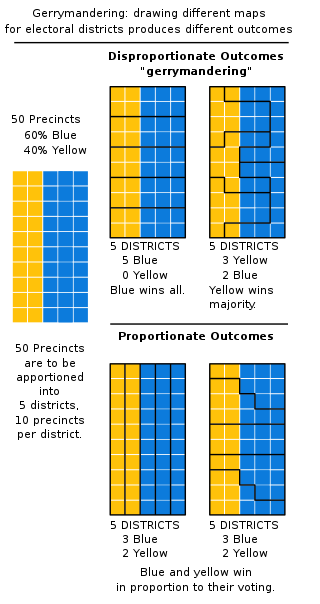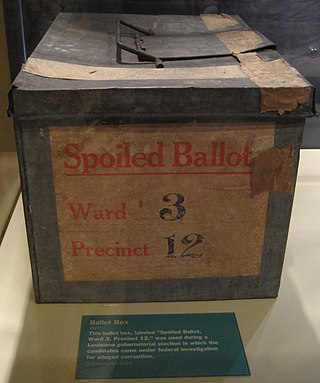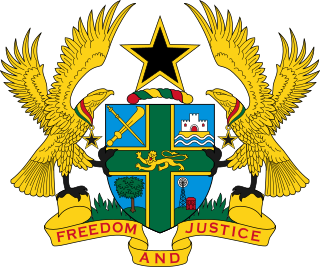
In representative democracies, gerrymandering is the political manipulation of electoral district boundaries with the intent to create undue advantage for a party, group, or socioeconomic class within the constituency. The manipulation may involve "cracking" or "packing". Gerrymandering can also be used to protect incumbents. Wayne Dawkins, a professor at Morgan State University, describes it as politicians picking their voters instead of voters picking their politicians.

A political party is an organization that coordinates candidates to compete in a particular country's elections. It is common for the members of a party to hold similar ideas about politics, and parties may promote specific ideological or policy goals.
In political science, Duverger's law holds that in political systems with only one winner, two main parties tend to emerge with minor parties typically splitting votes away from the most similar major party. In contrast, systems with proportional representation usually have more representation of minor parties in government.

A protest vote is a vote cast in an election to demonstrate dissatisfaction with the choice of candidates or the current political system. Protest voting takes a variety of forms and reflects numerous voter motivations, including political apathy. Where voting is compulsory, casting a blank vote is available for those who do not wish to choose a candidate, or to protest. Unlike abstention elsewhere, blank votes are counted.

A political campaign is an organized effort which seeks to influence the decision making progress within a specific group. In democracies, political campaigns often refer to electoral campaigns, by which representatives are chosen or referendums are decided. In modern politics, the most high-profile political campaigns are focused on general elections and candidates for head of state or head of government, often a president or prime minister.

In political science, voter turnout is the participation rate of a given election. This is typically either the percentage of registered voters, eligible voters, or all voting-age people. According to Stanford University political scientists Adam Bonica and Michael McFaul, there is a consensus among political scientists that "democracies perform better when more people vote."
Political polarization is the divergence of political attitudes away from the center, towards ideological extremes.
Direct election is a system of choosing political officeholders in which the voters directly cast ballots for the persons or political party that they desire to see elected. The method by which the winner or winners of a direct election are chosen depends upon the electoral system used. The most commonly used systems are the plurality system and the two-round system for single-winner elections, such as a presidential election, and proportional representation for the election of a legislature or executive.
An indirect election or hierarchical voting is an election in which voters do not choose directly among candidates or parties for an office, but elect people who in turn choose candidates or parties. It is one of the oldest forms of elections and is used by many countries for heads of state, cabinets, heads of government, and/or upper houses. It is also used for some supranational legislatures.

In the politics of the United States, elections are held for government officials at the federal, state, and local levels. At the federal level, the nation's head of state, the president, is elected indirectly by the people of each state, through an Electoral College. Today, these electors almost always vote with the popular vote of their state. All members of the federal legislature, the Congress, are directly elected by the people of each state. There are many elected offices at state level, each state having at least an elective governor and legislature. There are also elected offices at the local level, in counties, cities, towns, townships, boroughs, and villages; as well as for special districts and school districts which may transcend county and municipal boundaries.

Elections in Georgia are held to fill various state and federal seats. Regular elections are held every even year. The positions being decided each year varies, as the terms of office varies. The State Senate, State House and U.S. House will typically be up for election, as all of those positions have two-year terms. Special elections are held to fill vacated offices. Georgia is one of seven states that require a run-off election if no candidate receives a majority of the vote in a primary election. Uniquely, Georgia requires a run-off election for state and congressional offices if no candidate wins a majority of the vote in a general election; only Louisiana has a similar requirement, but it operates under a different election system.

Ghana elects on national level a head of state, the president, and a legislature. The president is elected for a four-year term by the people. The Parliament of Ghana has 275 members, elected for a four-year term in single-seat constituencies. The presidential election is won by having more than 50% of valid votes cast, whilst the parliamentary elections is won by simple majority, and, as is predicted by Duverger's law, the voting system has encouraged Ghanaian politics into a two-party system, creating extreme difficulty for anybody attempting to achieve electoral success under any banner other than those of the two dominant parties. Elections have been held every four years since 1992. Presidential and parliamentary elections are held alongside each other, generally on 7 December every four years.
Congressional stagnation is an American political theory that attempts to explain the high rate of incumbency re-election to the United States House of Representatives. In recent years this rate has been well over 90 per cent, with rarely more than 5–10 incumbents losing their House seats every election cycle. The theory has existed since the 1970s, when political commentators were beginning to notice the trend, with political science author and professor David Mayhew first writing about the "vanishing marginals" theory in 1974.

Elections in Pennsylvania elect the five state-level offices, the Pennsylvania General Assembly, including the senate and house of representatives, as well as the state's congressional delegation for the United States Senate and the United States House of Representatives. Presidential elections are held every four years in Pennsylvania. The state is one of the most competitive nationally, with narrow victories that alternate between the parties across all major offices. On the presidential level, the state has been considered a swing state throughout its entire history as it only voted for the nationwide loser on only 10 occasions. Meaning it has voted for the national winner 83% of the time, as of 2020.

Elections in Vermont are authorized under Chapter II of the Vermont State Constitution, articles 43–49, which establishes elections for the state level officers, cabinet, and legislature. Articles 50–53 establish the election of county-level officers.
A valence issue is an issue where there is a broad amount of consensus among voters. As valence issues are representative of a goal or quality, voters use valence issues to evaluate a political party’s effectiveness in producing this particular goal or quality.
Anocracy, or semi-democracy, is a form of government that is loosely defined as part democracy and part dictatorship, or as a "regime that mixes democratic with autocratic features". Another definition classifies anocracy as "a regime that permits some means of participation through opposition group behavior but that has incomplete development of mechanisms to redress grievances." The term "semi-democratic" is reserved for stable regimes that combine democratic and authoritarian elements. Scholars distinguish anocracies from autocracies and democracies in their capability to maintain authority, political dynamics, and policy agendas. Similarly, the regimes have democratic institutions that allow for nominal amounts of competition. Such regimes are particularly susceptible to outbreaks of armed conflict and unexpected or adverse changes in leadership.
A hybrid regime is a type of political system often created as a result of an incomplete democratic transition from an authoritarian regime to a democratic one. Hybrid regimes are categorized as having a combination of autocratic features with democratic ones and can simultaneously hold political repressions and regular elections. Hybrid regimes are commonly found in developing countries with abundant natural resources such as petro-states. Although these regimes experience civil unrest, they may be relatively stable and tenacious for decades at a time. There has been a rise in hybrid regimes since the end of the Cold War.

The 2020 elections for the Florida Senate took place on Tuesday, November 3, 2020, to elect state senators from 20 of 40 districts. The Republican Party has held a Senate majority since 1995. The result was a one-seat gain for the Republicans, thus maintaining their majority.

Elections to the European Parliament saw declining voter turnout between 1979 and 2014. However, voter turnout in 2019 European elections increased by 8 points compared to 2014. In spite of this exception for all Member States, the electoral mobilization remains weak compared to the national parliamentary elections. Moreover, turnout significantly differs from one country to another in Europe and across a time: in 2019 Belgium citizens participated the most with 88.47% and Slovakians the less with 22.74%. The potential factors that might influence these trends and their implications have attracted great scholarly attention. Identifying and analysing the factors that determine the relative low turnout at European elections is therefore critical, as it is one element that weakens the democratic legitimacy of the European Parliament.












